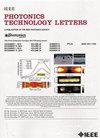An Accurate Method for Refractive Index Measurement of PDMS Using a DOE Beam Splitter
IF 2.3
3区 工程技术
Q2 ENGINEERING, ELECTRICAL & ELECTRONIC
引用次数: 0
Abstract
Polydimethylsiloxane (PDMS) is widely used in optical devices due to its high transparency, biocompatibility, chemical inertness and easy fabrication. Accurate measurement of the PDMS refractive index (RI) is critical for optical applications. In this study, a simple, accurate and reliable method is proposed for measuring the RI of PDMS, which leverages diffractive optical element (DOE) to determine the RI of PDMS by analyzing the uniformity of DOE filled with PDMS. The uniformity of the DOE beam splitter directly depends on the RI difference between the DOE material and filling material. The用DOE分束器精确测量PDMS折射率的方法
聚二甲基硅氧烷(PDMS)具有高透明度、生物相容性、化学惰性和易于制造等优点,在光学器件中得到了广泛的应用。PDMS折射率(RI)的精确测量对光学应用至关重要。本研究提出了一种简单、准确、可靠的测量PDMS RI的方法,即利用衍射光学元件(diffraction optical element, DOE),通过分析PDMS填充后DOE的均匀性来确定PDMS的RI。DOE分束器的均匀性直接取决于DOE材料和填充材料之间的RI差。$3\乘以3$、$3\乘以5$、$3\乘以7$和$5\乘以5$ DOE分束器采用迭代傅里叶变换算法(IFTA)设计,并通过一步制造用于PDMS的RI测量。使用该方法测量的PDMS的RI显示,1550 nm处的平均nPDMS为1.3826,标准差为0.001,与光谱椭偏法(SE)测量的平均nPDMS为1.3934的标准差为0.012相比,提高了12倍。该方法具有较高的精度和可靠性,可以测量与旋涂或浇铸在制造的DOE分束器上兼容的任何未知透明材料的RI。
本文章由计算机程序翻译,如有差异,请以英文原文为准。
求助全文
约1分钟内获得全文
求助全文
来源期刊

IEEE Photonics Technology Letters
工程技术-工程:电子与电气
CiteScore
5.00
自引率
3.80%
发文量
404
审稿时长
2.0 months
期刊介绍:
IEEE Photonics Technology Letters addresses all aspects of the IEEE Photonics Society Constitutional Field of Interest with emphasis on photonic/lightwave components and applications, laser physics and systems and laser/electro-optics technology. Examples of subject areas for the above areas of concentration are integrated optic and optoelectronic devices, high-power laser arrays (e.g. diode, CO2), free electron lasers, solid, state lasers, laser materials'' interactions and femtosecond laser techniques. The letters journal publishes engineering, applied physics and physics oriented papers. Emphasis is on rapid publication of timely manuscripts. A goal is to provide a focal point of quality engineering-oriented papers in the electro-optics field not found in other rapid-publication journals.
 求助内容:
求助内容: 应助结果提醒方式:
应助结果提醒方式:


